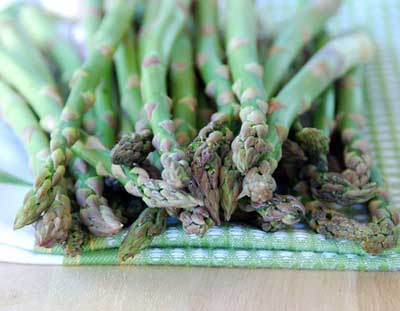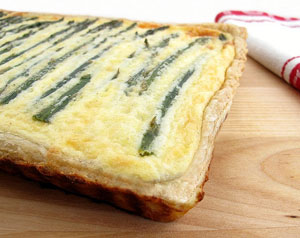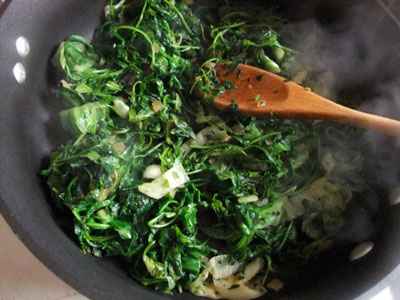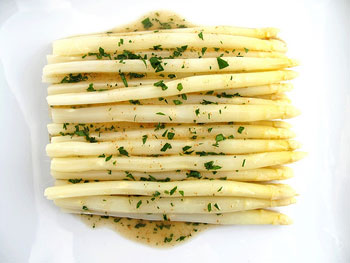 Typically the arrival of thistle shaped green vegetables such as asparagus and artichokes signal that Spring has sprung. But last week I was seduced into buying some exotic looking white asparagus and violet artichokes, each of which are much more common in Europe than they are here in the states. Fortunately interest in a greater variety of vegetables is growing and so they are getting easier and easier to find. My two sources? Berkley Bowl and Trader Joe's.
Typically the arrival of thistle shaped green vegetables such as asparagus and artichokes signal that Spring has sprung. But last week I was seduced into buying some exotic looking white asparagus and violet artichokes, each of which are much more common in Europe than they are here in the states. Fortunately interest in a greater variety of vegetables is growing and so they are getting easier and easier to find. My two sources? Berkley Bowl and Trader Joe's.
Last week I got a chance to go to Berkley Bowl for the first time. Berkeley Bowl is an independent supermarket that puts the big chains to shame. The produce section is what they are most famous for and it truly is impressive. While not as elegant as the great food halls in London, the variety and volume is way beyond what I'm accustomed to. Prices are moderate, I bought a pound of white asparagus and a four pack of Belgian endive, for a little over two dollars each.
Spring
Spring
How to Select, Store, and Cook with Asparagus
 It's May 12th, and asparagus season is nearly over here in Southern California. While the majority of the country enjoys asparagus from April to June, our season usually stretches from late February to early May.
It's May 12th, and asparagus season is nearly over here in Southern California. While the majority of the country enjoys asparagus from April to June, our season usually stretches from late February to early May.
I'm not sad though -- this season's asparagus has been superb. The smooth, svelte green stalks with delicate purple tinged tips have had a mildly earthy flavor and deliciously tender texture. Since I've been buying two bunches of asparagus nearly every week for the last two months, I've learned a few things, So here are some tips on how to select, store, and cook with asparagus.
How to select asparagus: What's better, thin or thick stalks of asparagus?
Both. No, that's not a typo. Every spring there is an endless debate over which is better, thin or thick stalks. Most people swear thick asparagus stalks are tough. I disagree. I have eaten many tender and flavorful thick stalks of asparagus. What' really important is the quality of the stalk: look for straight, firm green stalks with light purple tinged tips. Look at the bottoms of the stalks. If they're white, dry, and woody, then they're probably old. Also avoid shriveled, overly dry, or pitted stalks.
Asparagus, Bacon & Cheese Quiche
 One of the first signs that spring has arrived is the availability of bright green vegetables, like asparagus. There is something special about an asparagus spear emerging from the ground. Right now asparagus is available at the Union square Greenmarket. In the supermarket it's available all-year round, but the best time to get pencil-thin asparagus is during springtime. It's at its most tender and succulent. Steamed for a few minutes, roasted, or grilled, asparagus is a delightful vegetable prepared in any which way. Its color becomes vivid green after cooking and for me that represents the essence of spring.
One of the first signs that spring has arrived is the availability of bright green vegetables, like asparagus. There is something special about an asparagus spear emerging from the ground. Right now asparagus is available at the Union square Greenmarket. In the supermarket it's available all-year round, but the best time to get pencil-thin asparagus is during springtime. It's at its most tender and succulent. Steamed for a few minutes, roasted, or grilled, asparagus is a delightful vegetable prepared in any which way. Its color becomes vivid green after cooking and for me that represents the essence of spring.
I enjoy eating asparagus in many forms, but I like it most in quiche, one of the favorite brunch foods here in the States. Though the French even eat it for lunch or dinner. Quiche was originally meant just for breakfast in the French province of Lorraine, from where it originated. Surprisingly the tradition of quiche-making comes from a time when Lorraine belonged to Germany. The dish used to be called kuchen, which is German for cake, and instead of a pie crust, it was made with bread dough—basically a pizza. Once the region changed rule, the German name was eventually transliterated into French and the recipe changed too. The most well-known recipe is Quiche Lorraine, filled with just bacon.
Sautéed Mixed Greens
 Bags of organic arugula at the store always tempt me. "Buy me!" they say, "Eat salad for a week, it'll be great!" Of course after three or four days the bag is half full and the contents start to look rather wilted and sad. Then comes regret. Why did I buy that bag in the first place? Recently I found the solution to the problem of wilting greens, a problem that I'm guessing may also be yours.
Bags of organic arugula at the store always tempt me. "Buy me!" they say, "Eat salad for a week, it'll be great!" Of course after three or four days the bag is half full and the contents start to look rather wilted and sad. Then comes regret. Why did I buy that bag in the first place? Recently I found the solution to the problem of wilting greens, a problem that I'm guessing may also be yours.
It turns out arugula is quite wonderful when lightly sauteed in olive oil. It's somewhat bitter and earthy but in a good way. It's even better if you mix it with some other greens. I use a bit of frozen spinach which is mild but silky and some fresh escarole which has a lovely spring flavor and juiciness when it's cooked. The mixture of flavors and textures creates a compelling dish that isn't just a terrific side dish, but begs to be layered in a grilled cheese sandwich. With or without ham or bacon, this is good stuff!
Cooking with White Asparagus
 Everyone knows green asparagus—it's making an appearance right now in the markets, announcing that spring has arrived. But not everyone knows white asparagus. It rarely shows up in the market because it's such a specialty but it's definitely worth searching for. Not only does the color (or absence of) make it unique, its flavor is more delicate and milder than green asparagus. But why is it white?
Everyone knows green asparagus—it's making an appearance right now in the markets, announcing that spring has arrived. But not everyone knows white asparagus. It rarely shows up in the market because it's such a specialty but it's definitely worth searching for. Not only does the color (or absence of) make it unique, its flavor is more delicate and milder than green asparagus. But why is it white?
White asparagus is not a genetically modified variety, which most people would assume. It's really just green asparagus that has been kept from turning green. To keep it from turning green farmers cover the asparagus with mulch before it sprouts from the ground. This keeps out the light, shuts off photosynthesis, and produces the pale cream-colored spears.
Cooking with white asparagus is not much different than green, however, it's recommended that you peel the stalks because the skins tend to be tough and bitter. The simplest way to prepare it is just to boil it. Typically a hollandaise sauce or melted butter would then go on top but my recipe features a savory brown butter vinaigrette made with tangy lemon juice and sherry vinegar. It's perfect as an appetizer or even a side dish for any spring menu.
More Articles ...
Welcome to the new One for the Table ...
Our Home Page will be different each time you arrive.
We're sure you'll find something to pique your interest...

